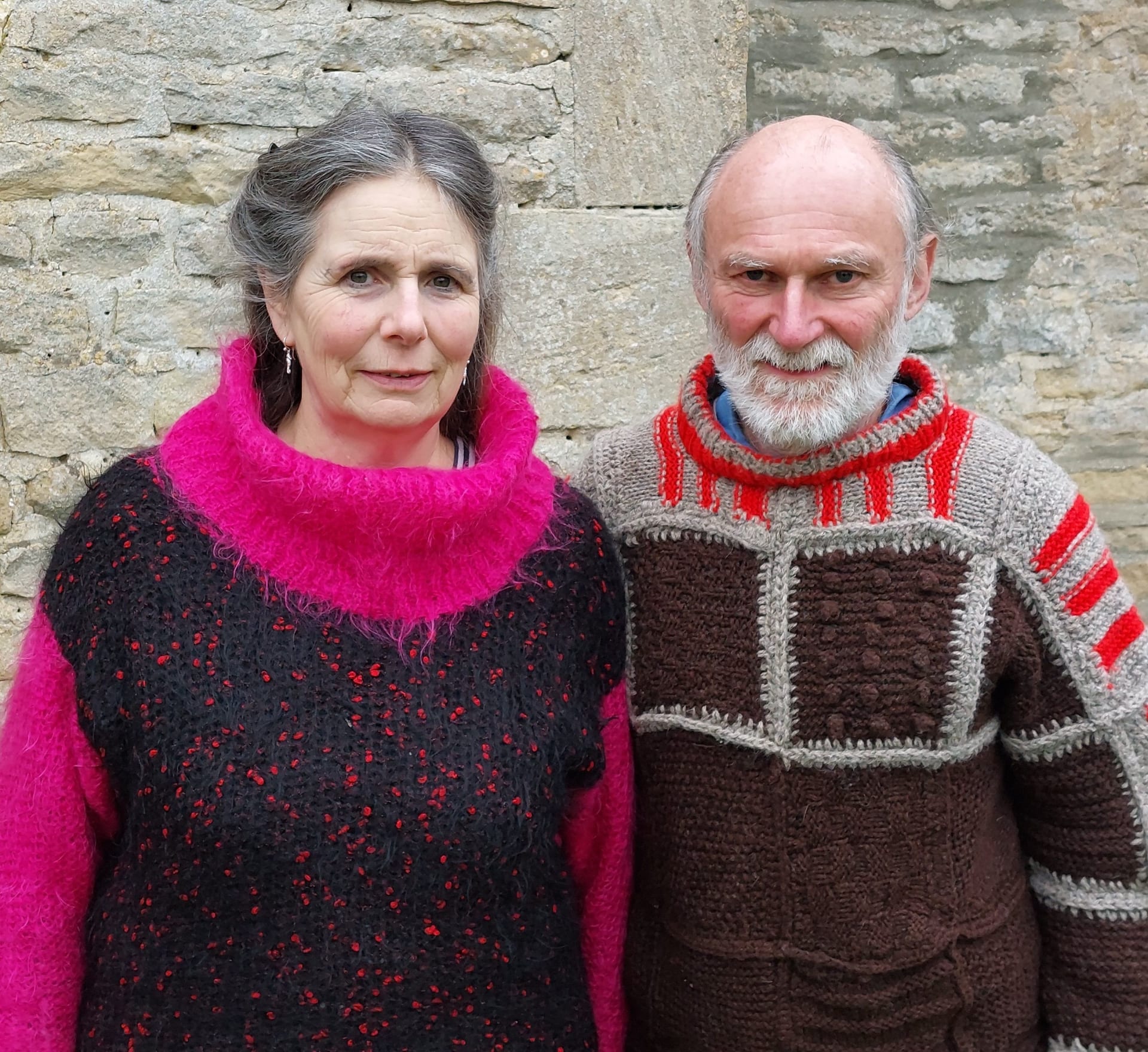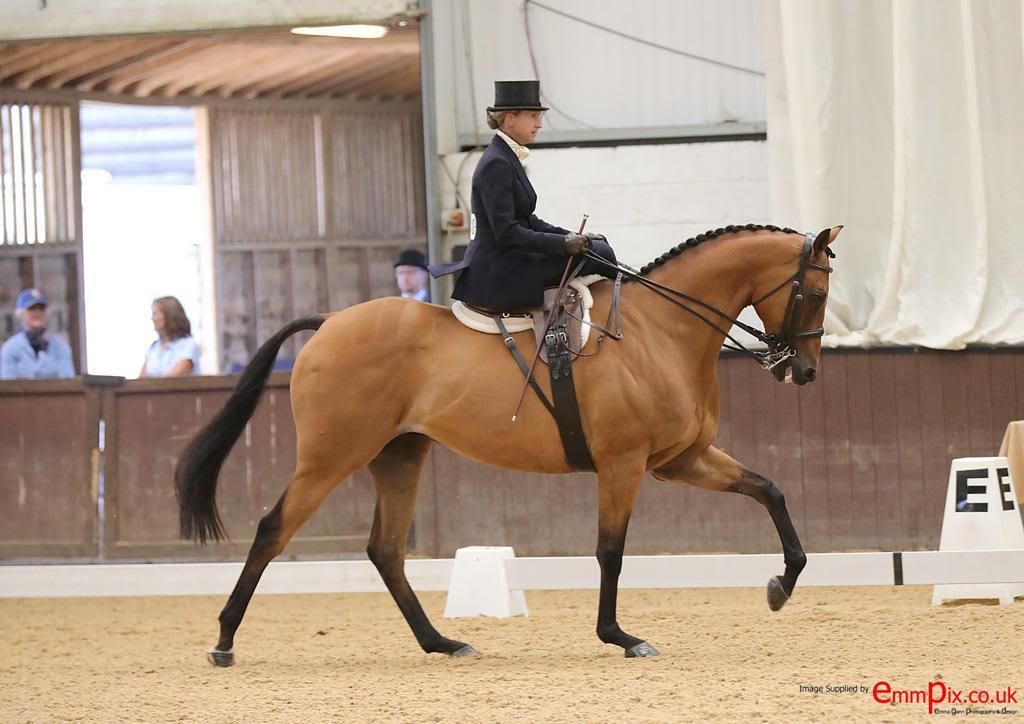When artist Julia Sorrell contacted me to see if I thought our readers might be interested in the story of how she and husband, Ian, renovated their property in Shipton-under-Wychwood, I jumped at the chance to learn more. Their aim was to use as many recycled materials as possible, and they will be opening their home to visitors during Oxfordshire Artweeks in May.
A well-established and highly regarded artist in her own right (elected to the Royal Institute of Painters in Water Colour in 2008 and the Royal Society of British Artists in 2009), Julia is the daughter of artist and archaeological illustrator, Alan Sorrell and watercolourist, Elizabeth Sorrel. Before we got onto the cottage renovations, I wanted to know more about Julia’s work and whether her childhood was as bohemian as I might imagine: “Actually to my siblings and I, our childhood was totally normal, but when I talk to other people about my upbringing, I realise just how different we were from our contemporaries. With such an upbringing, it allowed one to think independently and outside the box as it were.”
And is your artistic style influenced by your parents?
Most definitely, as my parents were always professional practising artists. The influences surrounded and engulfed me throughout my childhood. They were inspiring and engaging, and being a restless child, my mother was delighted to find from the age of three the only way of making me concentrate was through hand-embroidery. I have developed very differently from them as an artist, but many underlying beliefs remain like drawing (looking and looking) not frightened by being an individual and encouraging to voice opinions, which, as woman, was invaluable to maintain one’s own opinions, rather than doing as one is told.
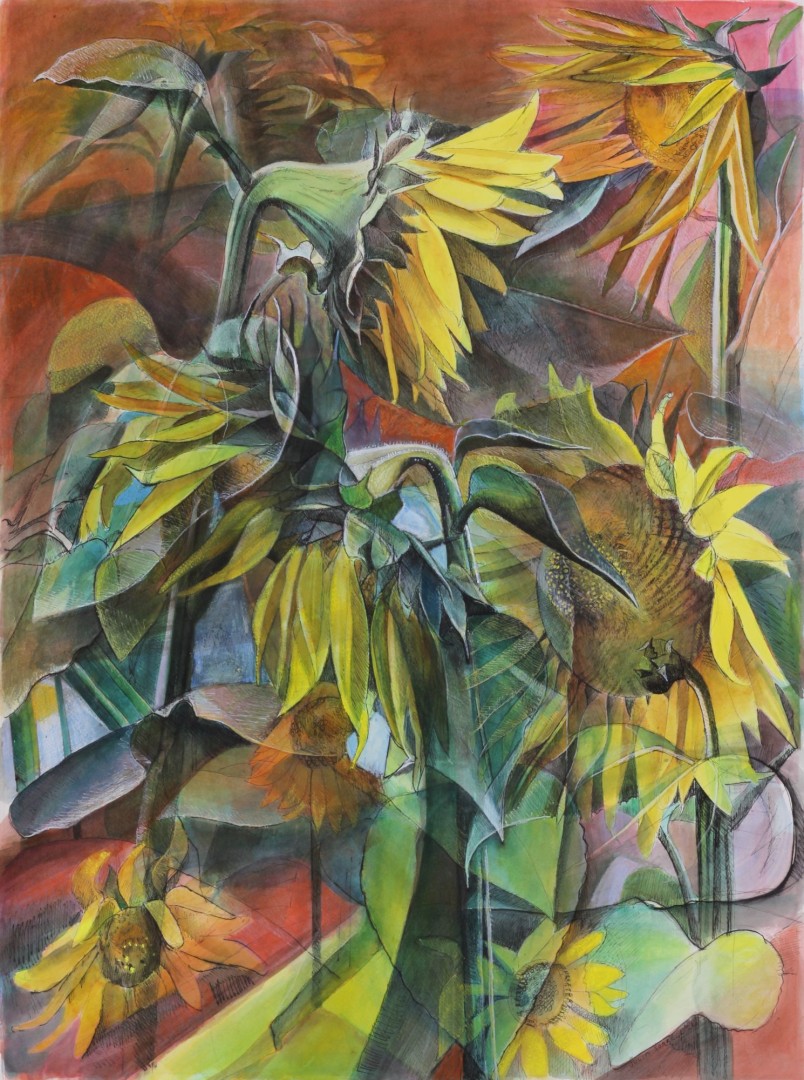
Your dreamscapes and figurative works have an almost ecclesiastical quality. Is this an accurate description?
I am not a religious person, but more likely spiritual. I visualise the world between reality and the dream – real and unreal – the leaf or a piece of wood that, when looked into, is a landscape. To take people to my world that does not exist but could.
What makes something interesting for you to work on?
I like to create my own timeless world which is not the normal world of cups, saucers or cars and fashion – the real world. I find I can enter this by looking intensely into the natural world for inspiration. Within the natural world there is an infinite variety of abstract shape.
You have achieved some truly remarkable feats during your career. Of which are you most proud?
I consider my life as a journey or discovery through my work. As people we are forever changing due to circumstances, experience, age etc, and, for me, art has been an integral part of this. I always have my head buzzing with new ideas. There have been many chapters in life, but I know I could always do better, so I have never got to the stage of being proud of what I have produced.
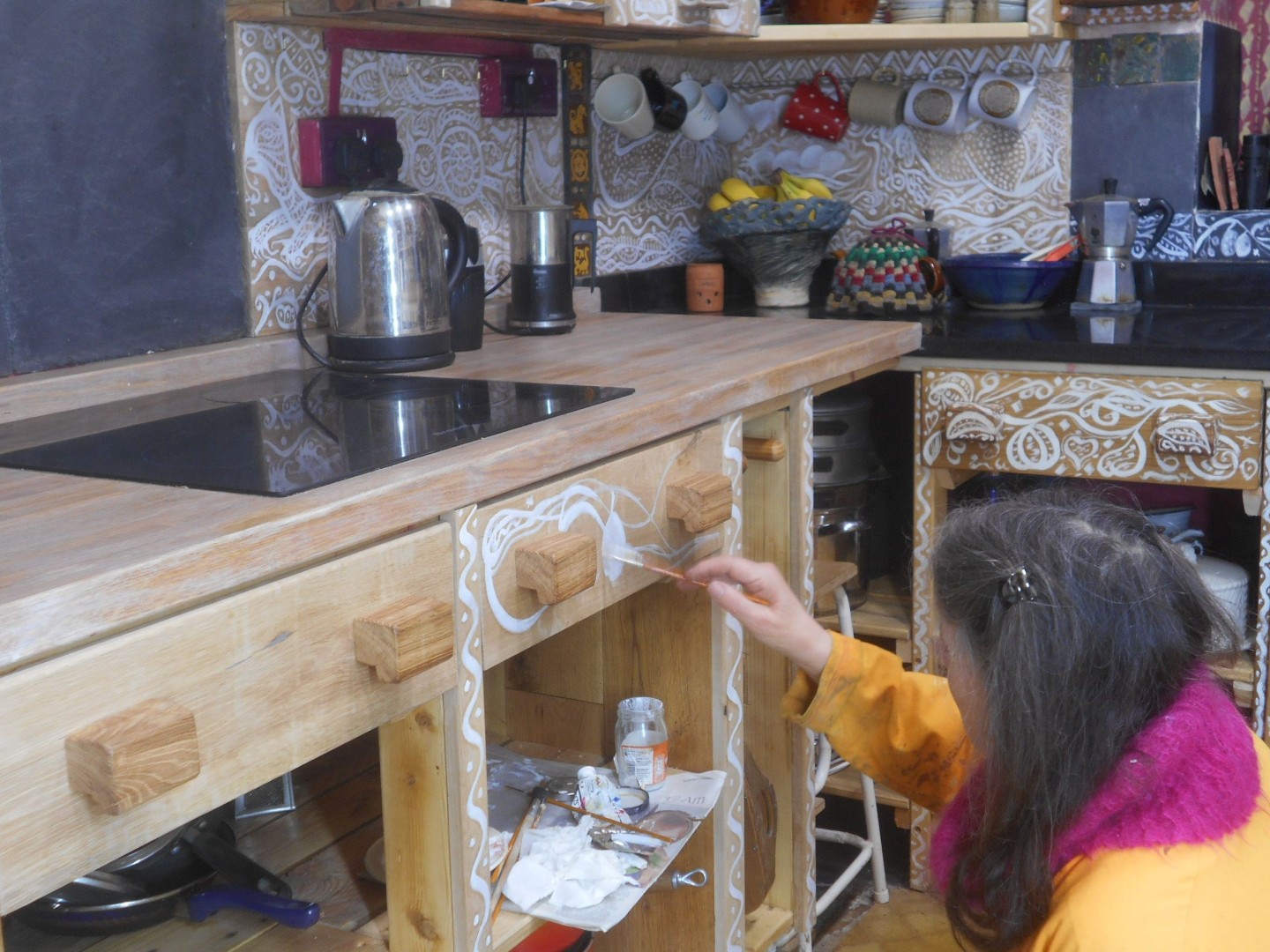
I understand you moved into the property in Shipton-under-Wychwood in 2019. Where were you based before?
We moved from Norfolk where we had created a very personal home with murals, mosaics and a beautiful wooden kitchen created by Ian. It won the best cottage award in Channel 4’s Best Britain Homes 2003 and received a lot of publicity.
Were you actively looking for a ‘do-er upper’?
No, we were not looking for a new project, but when we found this house, we knew we could not live with the melamine and beige walls covered with plastic wallpaper and plastic paint. We had, once again, to personalise it our own way, not being influenced by fashions of the day. We were guided by the wish to carry on the same ethos as we have always lived by.
All my life I have re-used environmentally friendly materials. My grandmother had the Northern tradition of making beautiful rag-rugs from used materials, and my mother believed in ‘Don’t buy what you can make’. As we had little money in my childhood, we were brought up to re-use. Likewise, Ian and I have always tried to re-use stuff. In our last house, broken pots and tiles were used in mosaics, curtains made from scraps of materials, wooden features from waney edges cut from straightened boards etc, and features made from thrown away objects: ‘Make do and mend’. So we have continued here by finding so much perfectly good stuff thrown away which, with imagination, can be re-made into something useful. We hate waste and the unnecessary spending on materials which have a detrimental effect environmentally. We have always believed in sustainability.
Were you already an experienced in the skills you needed? If not, how did you learn them?
A lot of skills we already had like painting, woodwork, sewing, but we have had to teach ourselves new skills or develop them in new directions. We learnt them by experimenting (we often make mistakes!) and looking up things on Youtube to do as much as we can ourselves; plumbing, electrics, fitting windows, basic building work. Some things we learnt from our son Henry Sanders, who is a conservation architect with many Oxfordshire churches in his care (hestiaarchitects.co.uk), like using lime for mortar and plasters which has cured damp problems.

Which other materials have you used?
We have made breathable paints from lime, and pigments and clay with tapioca as a binder. In one room the clay comes from the cliffs of Covehithe in Suffolk which we used to visit. Recently we have used graphene-based paints which are breathable but have stronger colours. Recycled fabrics to weave curtains and fleece for carpets – which farmers would otherwise be burning because there is no longer a market for wool. Shelves have been made from old scaffolding boards and pallets in the case of the kitchen and doors. Floorboards have been reused from a house in Oxford – oak flooring boards from a house which was flooded – have been used for the kitchen, and we also got the kitchen surfaces. Roofing slates have been used as tiles in the bathroom and kitchen, the old oak kitchen doors sanded and used as wall panels and buttons for mosaics.
We’d love to know more about Ian’s work. What inspired his hand-carved tables and how long has he been making them?
Ian: I have been making the tree-tables since 2001. It started with us needing a new kitchen unit in our last house in Norfolk, Julia wanting it all to have waney edges. Having a local wood yard, I purchased a nine foot long, two inch thick piece of elm with a waney edge for the counter, and waney edged elm for the underneath and then set to and made it all. That was followed by a kitchen table with a single oak top with two oak logs to support it, which we now have here in Oxfordshire. My feeling was that carpentry and carpentry equipment was all based on straight lines, when little is straight in nature, especially the inspiring old British trees we so love in the countryside. Hence hand-carving the logs from the British native trees back to their original forms. Many of my clients live in towns and modern estates, and I often wonder if my tables are bringing into their houses something they subconsciously miss within the environment they live?
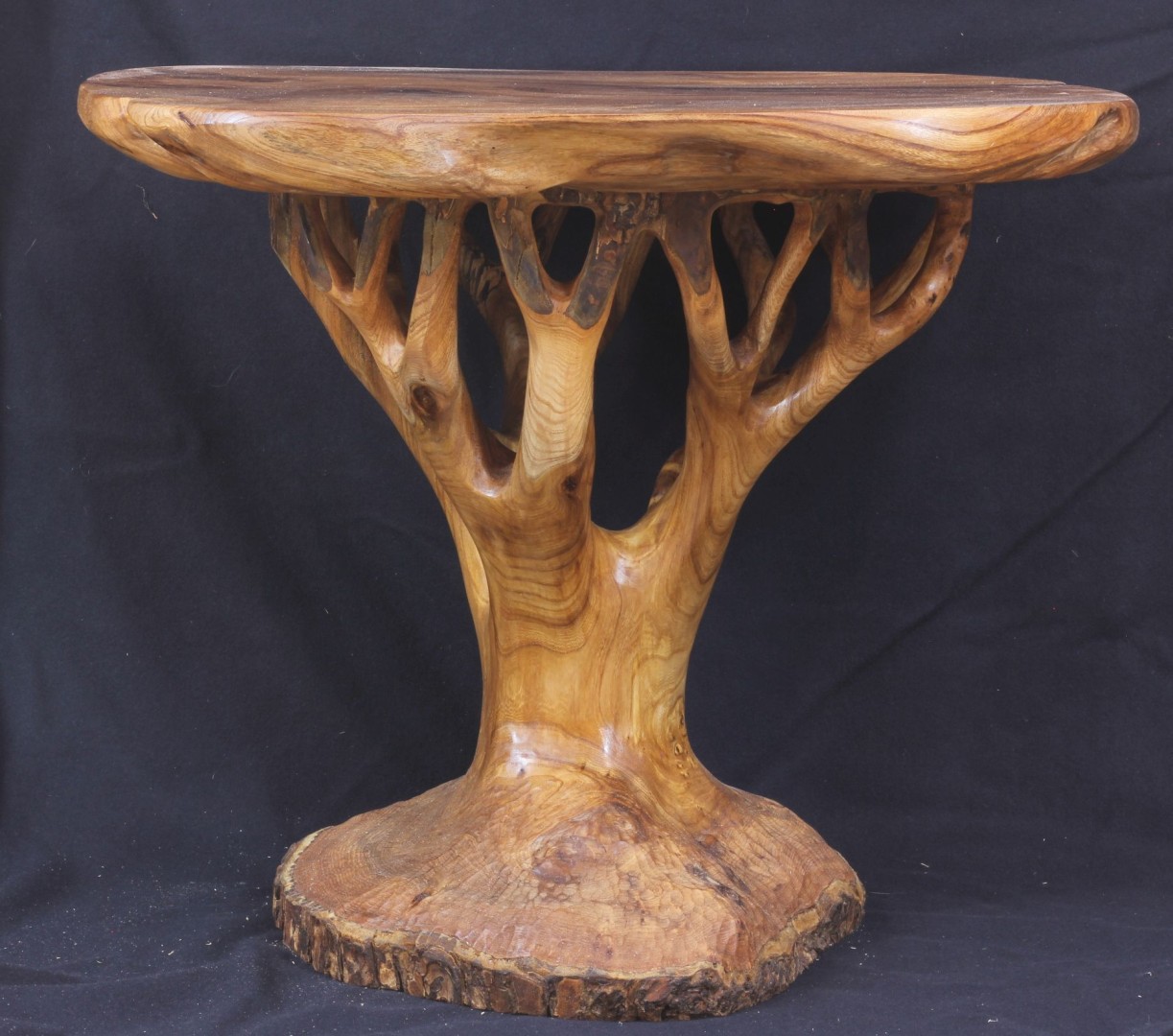
I understand you have both now turned attention to your garden. How is that going, and what have you planned?
There was not much of a garden when we arrived, the house was surrounded on two sides by Leylandii which was contributing to the damp issue. Ian cut back the Leylandii, some of which are used to support our climbing roses. This has been added to with a metal arbour which Ian welded together with the help of a friend. I, then, set to on making a front garden, working out what grows well in the wet clay soil – many being native wild plants. Some things are spontaneous such as the wild strawberries which provide ground cover and fruits for my grandson to search out. Plants are grown as part of my palette as a painter, such as sunflowers and artichokes, as well as a haven for wildlife.
Ian established an orchard with heritage fruit trees from Oxfordshire and beyond, as well as a wide selection of British native trees. Together we have planted thousands of bulbs. The house came with an ancient unimproved water-meadow which just needed traditional management to come back into life as a species rich wild-flower meadow, which Ian adds to with fritillaries, cowslips etc. We are therefore part of wetland meadows regeneration of the Evenlode Valley, encouraged by the Evenlode Catchment Partnership and the North-East Cotswolds Farm Cluster. Within the meadow we have installed a shepherds hut, which we rent out (littlestockshepherdshut.co.uk). We have finished and decorated this in the same manner as the house, with a wool mattress, duvet and patchwork quilt, and hand-woven wool curtains and living fleece carpet.
Finally, what do you enjoy most about opening your home for Artweeks?
It is lovely to be able meet people and showcase one’s work to a wide audience.
For more information and to find out more about visiting Julia and Ian to view their work, visit juliasorrell.com

